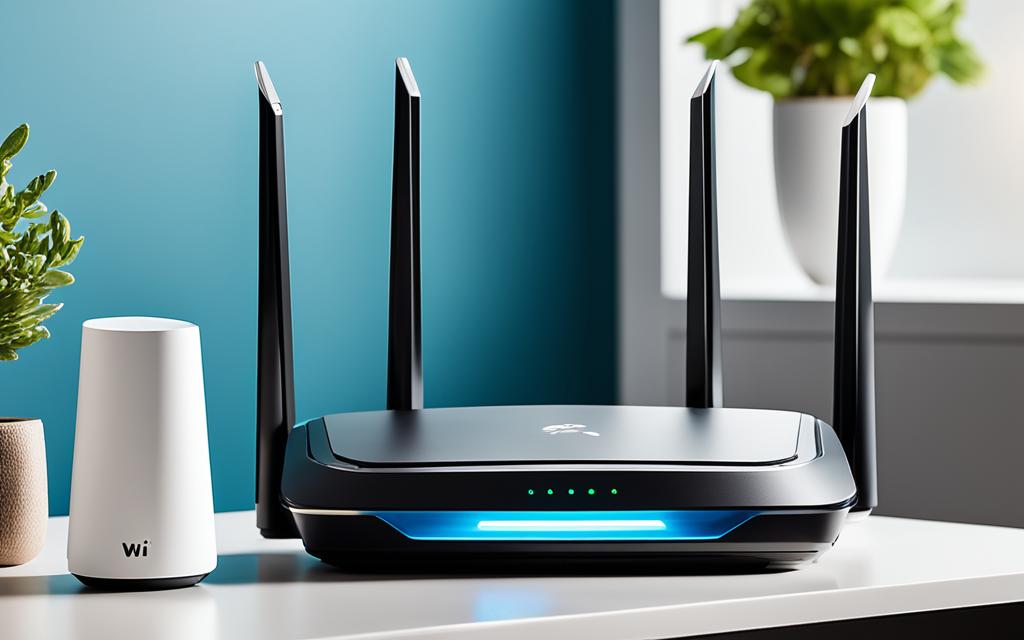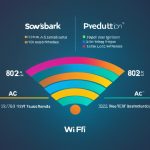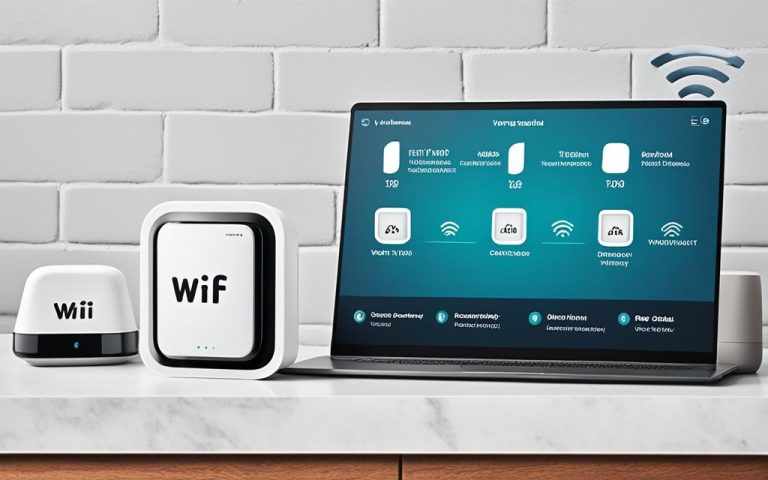Wi-Fi 6, also known as 802.11ax, is the latest generation and standard for wireless networking that replaces the 802.11ac, or Wi-Fi 5, standard. Wi-Fi 6 offers a range of advancements and improvements over previous standards, including higher data rates, increased capacity, improved power efficiency, and better performance in environments with many connected devices. It is designed to meet the demands of today’s most demanding Wi-Fi environments, such as stadiums and corporate networks, while also supporting the Internet of Things (IoT).
With Wi-Fi 6, users can experience faster and more reliable connectivity for a wide range of applications, from streaming high-definition videos to mission-critical business operations.
Wi-Fi 6 advancements have brought significant improvements to local area wireless networks. The higher data rates and increased capacity allow for faster and more efficient communication, enabling seamless connectivity even in high-density environments. Moreover, the improved power efficiency extends the battery life of connected devices, providing a more convenient user experience.
In addition, Wi-Fi 6’s better performance in crowded environments ensures that users can maintain a reliable connection even in areas with numerous connected devices. This is particularly beneficial for public spaces, workplaces, and homes where multiple devices are used simultaneously.
Overall, the advancements of Wi-Fi 6 have revolutionized local area wireless networks, providing enhanced speed, capacity, power efficiency, and performance. Its capabilities are driving the adoption of Wi-Fi 6 as the standard for wireless connectivity, ensuring a seamless and reliable experience for users in a wide range of environments.
Understanding Wi-Fi 6: Features and Benefits
Wi-Fi 6, also known as 802.11ax, brings a host of features and benefits that differentiate it from previous Wi-Fi standards. These advancements position Wi-Fi 6 as the go-to choice for high-demand environments with numerous connected devices. Let’s delve into the key features and benefits that make Wi-Fi 6 a game-changer:
Lower Overall Latency
Wi-Fi 6 significantly reduces latency, ensuring faster response times and smoother user experiences. This improvement is especially crucial for applications requiring near-real-time interactions, such as online gaming and video conferencing.
Improved Connection Quality
With Wi-Fi 6, users can enjoy a more stable and reliable connection. This enhancement is particularly beneficial in environments with environmental challenges or interference, as it helps maintain consistent performance throughout the coverage area.
Potentially Better Intracell Roaming
Wi-Fi 6 introduces techniques that enhance intracell roaming, allowing devices to seamlessly transition between access points while maintaining a continuous connection. This smooth roaming experience is crucial for mobility and ensures uninterrupted connectivity as users move within a network.
Faster Data Transfer
Wi-Fi 6 achieves faster data transfer speeds than its predecessors, making it ideal for bandwidth-intensive applications like streaming 4K or 8K videos. This improvement ensures that users can enjoy high-quality content without any buffering or lag.
Increased Data Capacity per Cell
Wi-Fi 6 maximizes the utilization of the wireless spectrum, enabling higher data capacity per cell. This expansion allows for more simultaneous connections and data transmissions, meeting the demands of crowded environments where multiple devices need to connect concurrently.
Better Handling of High-Bandwidth Applications
Wi-Fi 6 is specifically designed to handle high-bandwidth applications with greater efficiency. It optimizes the delivery of content like ultra-high-definition videos and large file transfers, ensuring smooth playback and quick downloads.
Support for Higher User Density
Wi-Fi 6 can accommodate a larger number of users per access point (AP) and the overall wireless local area network (WLAN) system. This scalability is essential for environments with a high density of connected devices, such as airports, convention centers, and sports stadiums.
Improved Power Efficiency and Longer Battery Life
Wi-Fi 6 incorporates power-saving technologies that enhance the energy efficiency of client devices. This improvement results in longer battery life for smartphones, laptops, and other Wi-Fi-enabled devices, allowing users to stay connected for extended periods without worrying about frequent recharging.
Efficient Wireless Operations with OFDMA
Wi-Fi 6 employs orthogonal frequency-division multiple access (OFDMA) to optimize wireless operations. OFDMA enhances spectrum utilization by enabling simultaneous communication with multiple clients, ensuring efficient distribution of data within the network.
These remarkable features and benefits position Wi-Fi 6 as a powerful and versatile wireless networking solution. With lower latency, improved connection quality, faster data transfer, increased capacity, better power efficiency, and efficient wireless operations, Wi-Fi 6 unlocks a new era of connectivity and meets the demands of today’s connected world.
The Speed and Efficiency of Wi-Fi 6
One of the key advantages of Wi-Fi 6 is its speed and efficiency. With a maximum theoretical data rate of almost 10 Gbps when eight spatial streams and 160 megahertz channels are used, Wi-Fi 6 provides faster data transfer compared to previous Wi-Fi standards. However, it’s important to note that real-world performance may be lower than the theoretical maximum.
Wi-Fi 6 achieves its efficiency through features like OFDMA, which allows for better utilization of channels and simultaneous communication with multiple clients. It also uses enhanced modulation techniques like 1024 Quadrature Amplitude Modulation (QAM) to increase throughput.
| Feature | Description |
|---|---|
| OFDMA | Allows for better channel utilization and simultaneous communication with multiple clients. |
| 1024 QAM | An enhanced modulation technique that increases throughput. |
These speed and efficiency improvements make Wi-Fi 6 ideal for high-bandwidth applications and environments with high user density.
“Wi-Fi 6 provides faster data transfer compared to previous Wi-Fi standards.”
Upgrading to Wi-Fi 6: Considerations and Implementation
Upgrading to Wi-Fi 6 is a process that brings significant benefits to your network, but it requires careful planning and consideration of various factors specific to each environment. While it can be a fairly simple process in home or small business environments, larger networks may require more complex upgrades.
To upgrade to Wi-Fi 6, the first step is to get a new wireless router that supports this latest standard. This router will serve as the backbone of your upgraded network and ensure compatibility with Wi-Fi 6 devices. As you gradually phase in Wi-Fi 6 clients, you’ll start to experience the improved performance and features of this advanced technology.
In larger networks, the upgrade process can involve additional considerations. You may need to update switches and wireless controllers to support Wi-Fi 6 access points (APs). This will ensure seamless integration and maximize the benefits of Wi-Fi 6 throughout your network infrastructure. Additionally, you might need to upgrade the cabling to accommodate higher-capacity uplinks and enhance data transfer rates.
“Implementing Wi-Fi 6 involves a careful analysis of your network infrastructure and a comprehensive upgrade plan.”
Another important factor to consider when upgrading to Wi-Fi 6 is the power requirements of Wi-Fi 6 APs. These devices may have different power needs compared to previous generations, so it’s important to ensure that your network infrastructure can provide sufficient power to support the new access points.
If your network has been experiencing an increase in the number of connected devices, it may be necessary to redesign your wireless configuration. Wi-Fi 6 offers improved handling of high client densities, but optimizing your network to ensure smooth and reliable connections for all devices is essential.
Implementing Wi-Fi 6 requires careful planning, which involves a detailed analysis of your network infrastructure, understanding the power requirements, and ensuring compatibility with existing devices. By following a well-thought-out upgrade plan, you can fully harness the benefits of Wi-Fi 6 and future-proof your network for the demands of tomorrow.
| Considerations for Upgrading to Wi-Fi 6 | Implementation Steps |
|---|---|
| 1. Assess your current network infrastructure | 1. Research and choose a Wi-Fi 6 compatible wireless router |
| 2. Determine the power requirements of Wi-Fi 6 APs | 2. Phased implementation of Wi-Fi 6 clients |
| 3. Evaluate the need for switch and wireless controller updates | 3. Update switches and wireless controllers to support Wi-Fi 6 APs |
| 4. Consider potential cabling upgrades for higher-capacity uplinks | 4. Optimize network configuration for high client density |
| 5. Plan for a wireless redesign if necessary | 5. Ensure sufficient power supply for Wi-Fi 6 APs |

“By upgrading to Wi-Fi 6, you can future-proof your network and enjoy faster speeds, increased capacity, and improved performance.”
The Evolution of Wi-Fi Standards: From 802.11b to Wi-Fi 6
Wi-Fi standards have evolved significantly over the years, improving the way we connect and communicate wirelessly. From the initial introduction of 802.11b in 1999 to the latest Wi-Fi 6 standard, each generation has brought advancements and enhancements to meet the growing demands of wireless connectivity.
The journey of Wi-Fi standards started with the 802.11b standard, which offered a maximum data rate of 11 Mbps. It was followed by 802.11a and its higher data rates in the 5 GHz frequency band. Then came 802.11g, which combined the best of both 802.11a and 802.11b, offering higher data rates and backward compatibility. The introduction of 802.11n brought significant improvements, including faster speeds and increased range, making it widely adopted for both home and enterprise networks.
Next, we saw the emergence of 802.11ac, which introduced advancements like wider channels, multiple spatial streams, and beamforming techniques. This standard offered gigabit speeds and improved performance in high-density environments. However, the most recent and advanced standard is Wi-Fi 6, also known as 802.11ax.
Wi-Fi 6 builds upon the advancements of previous standards and introduces advanced features and capabilities to meet the demands of modern wireless networks. It offers faster speeds, increased capacity, and improved performance, especially in high-density environments with many connected devices. Wi-Fi 6 utilizes techniques like Orthogonal Frequency Division Multiple Access (OFDMA) to improve efficiency and enable simultaneous communication with multiple devices.
Here is a comparison of the key features and capabilities of each Wi-Fi standard:
| Wi-Fi Standard | Data Rate | Frequency Band | Key Advancements |
|---|---|---|---|
| 802.11b | 11 Mbps | 2.4 GHz | Initial Wi-Fi standard |
| 802.11a | 54 Mbps | 5 GHz | Higher data rates in the 5 GHz band |
| 802.11g | 54 Mbps | 2.4 GHz | Combination of 802.11a and 802.11b |
| 802.11n | 600 Mbps to 900 Mbps | 2.4 GHz or 5 GHz | Faster speeds, increased range |
| 802.11ac | 1.3 Gbps to 6.9 Gbps | 5 GHz | Wider channels, improved performance in high-density environments |
| Wi-Fi 6 (802.11ax) | Up to 9.6 Gbps | 2.4 GHz and 5 GHz | Faster speeds, increased capacity, improved performance in high-density environments |
Wi-Fi standards continue to evolve to keep up with the increasing demands of wireless connectivity. As technology advances and new use cases emerge, we can expect further improvements in data rates, range, and overall performance to provide seamless wireless experiences for users.
Wi-Fi 6E: Extending Wi-Fi 6 into the 6 GHz Frequency Band
Wi-Fi 6E is an extension of Wi-Fi 6 that operates in the 6 GHz frequency band. This extension allows for even greater bandwidth and performance improvements compared to Wi-Fi 6.
Wi-Fi 6E can utilize additional channels in the 6 GHz band, offering increased capacity for high-demand applications like high-definition video streaming and virtual reality. It also reduces interference from other devices operating in the 2.4 GHz and 5 GHz bands.
Wi-Fi 6E certification ensures that devices can operate in the 6 GHz spectrum with the required performance and efficiency. The availability of the 6 GHz band for Wi-Fi 6E in different countries is an important consideration for the adoption and deployment of this extended Wi-Fi standard.
The Future of Wi-Fi: Wi-Fi 7 and Beyond
While Wi-Fi 6 provides significant advancements in wireless connectivity, the industry is already looking ahead to the next generation of Wi-Fi standards. The successor to Wi-Fi 6, known as Wi-Fi 7 or 802.11be, is currently under study and is expected to be introduced in 2024. Wi-Fi 7 aims to provide ultra-high-throughput networks, building upon the features and capabilities of Wi-Fi 6. It will further enhance data rates, capacity, and efficiency, enabling even more demanding applications and use cases. Wi-Fi 7 represents the ongoing evolution of Wi-Fi technology, driven by the increasing demands for faster and more reliable wireless connectivity.
As we anticipate the arrival of Wi-Fi 7, let’s explore some of the key features and advancements that this future standard will bring:
- Higher Data Rates: Wi-Fi 7 is expected to deliver even faster data transfer speeds, allowing for smoother streaming of high-definition videos, more responsive online gaming experiences, and quicker downloads and uploads.
- Increased Capacity: With Wi-Fi 7, networks will be able to support a larger number of connected devices simultaneously, addressing the growing demands of smart homes, businesses, and IoT deployments.
- Improved Efficiency: Wi-Fi 7 will introduce new technologies and techniques to optimize wireless operations, reducing latency, improving power efficiency, and enhancing overall network performance.
- Enhanced Security: The future of Wi-Fi will prioritize stronger encryption protocols and improved security mechanisms to protect against evolving cybersecurity threats and safeguard sensitive data.
Just as Wi-Fi 6 revolutionized wireless connectivity, Wi-Fi 7 holds great promise in shaping the future of Wi-Fi networks. Its advanced capabilities will empower users, businesses, and industries to realize the full potential of emerging technologies, such as augmented reality, virtual reality, artificial intelligence, and the further expansion of the Internet of Things.
“Wi-Fi 7 represents the next step in the evolution of wireless networking, providing ultra-high-throughput and seamless connectivity for the modern digital world.”
The Roadmap of Wi-Fi Advancements
Let’s take a moment to visualize the progression of Wi-Fi standards over the years, culminating in the emergence of Wi-Fi 6 and the forthcoming Wi-Fi 7:
| Wi-Fi Standard | Release Year | Maximum Data Rate |
|:————–:|:————:|:—————–:|
| 802.11b | 1999 | 11 Mbps |
| 802.11a | 1999 | 54 Mbps |
| 802.11g | 2003 | 54 Mbps |
| 802.11n | 2009 | Up to 600 Mbps |
| 802.11ac | 2014 | Up to 6.9 Gbps |
| Wi-Fi 6 | 2019 | Up to 9.6 Gbps |
| Wi-Fi 7 | 2024 | Ultra-high-throughput |
As the chart demonstrates, each new Wi-Fi standard has built upon the successes and advancements of its predecessors, continually pushing the boundaries of wireless speeds, capacity, and efficiency. Wi-Fi 7 will extend this legacy by providing the framework for transformative connectivity that will meet the ever-increasing demands of our digital world.
Conclusion
The advancements in Wi-Fi 6 have brought about significant improvements in local area wireless networks. With higher data rates, increased capacity, improved power efficiency, and better performance in high-density environments, Wi-Fi 6 is revolutionizing the way we connect and communicate wirelessly.
As the number of devices and applications requiring fast and reliable connectivity continues to grow, Wi-Fi 6 has become the standard of choice for various environments, ranging from homes to corporate networks to public venues. Its features and capabilities make it highly suitable for meeting the demands of today’s digital world.
Looking ahead, the future of Wi-Fi remains promising with the ongoing development of Wi-Fi 7 and beyond. These future iterations will build upon the advancements of Wi-Fi 6, offering even greater advancements in wireless connectivity. As technology continues to evolve, Wi-Fi will stay at the forefront, providing faster speeds, increased capacity, and improved performance to cater to our ever-growing wireless needs.
FAQ
What is Wi-Fi 6?
Wi-Fi 6, also known as 802.11ax, is the latest generation and standard for wireless networking that offers a range of advancements and improvements over previous standards.
What are the key features and benefits of Wi-Fi 6?
Wi-Fi 6 offers lower latency, improved connection quality, faster data transfer, increased data capacity, better handling of applications, support for higher user density, improved power efficiency, and more efficient wireless operations.
How fast and efficient is Wi-Fi 6?
Wi-Fi 6 provides faster data transfer compared to previous standards, with a maximum theoretical data rate of almost 10 Gbps. It achieves efficiency through features like OFDMA and enhanced modulation techniques.
What is the process of upgrading to Wi-Fi 6?
Upgrading to Wi-Fi 6 involves getting a new wireless router that supports Wi-Fi 6 and gradually phasing in Wi-Fi 6 clients. In larger networks, the upgrade process may be more complex and require updates to switches, wireless controllers, and potential cabling upgrades.
What are the previous generations of Wi-Fi standards?
The previous Wi-Fi standards include 802.11b, 802.11a, 802.11g, 802.11n, and 802.11ac.
What is Wi-Fi 6E?
Wi-Fi 6E is an extension of Wi-Fi 6 that operates in the 6 GHz frequency band and offers greater bandwidth, performance improvements, increased capacity, and reduced interference.
What is the future of Wi-Fi after Wi-Fi 6?
The successor to Wi-Fi 6, known as Wi-Fi 7 or 802.11be, is under study and expected to be introduced in 2024. Wi-Fi 7 aims to provide ultra-high-throughput networks with further enhancements in data rates, capacity, and efficiency.



















